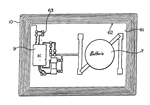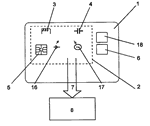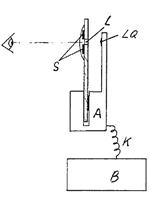Chip cards
(German original "Chipkarten" by Dipl.-Ing. Horst Weißenberger published in DPMA-Erfinderaktivitäten 1997)
The report provides an overview of the various types of chip cards, shows their rapid development and wide use, and describes the large range of applications of chip cards and security aspects.
After the magnetic stripe cards, chip cards have become more and more important in recent years. Even the name itself indicates a major difference between the magnetic stripe card and the chip card: integrated electrical components (chips) have been embedded in the latter. The collective term "chip card" refers to different types of cards. Other established terms are smart card and super smart card. DE 3811831A1 shows one of these cards (Fig. 1) which comprises a keyboard (12) in addition to a display (13). The keyboard can be used to type in a specific authorisation code for the card or to operate an included pocket-calculator.
The SIM card is another special form of the chip card. The only difference between these cards is their outer dimensions. The SIM card is considerably smaller than the chip card, but its contact field has the same size. Consequently, the SIM card can be used together with an adapter in credit card format in devices that were built for the larger chip card. DE 4419073A1 shows such a SIM card (2) with corresponding adapter (1) (Fig. 2).
The SIM card is typically used in mobile telephones. Due to their small size SIM cards have neither a keyboard nor a display.
Basically, two general categories of chip cards can be distinguished: contact cards and contactless cards. The contact card has a set of contacts; via these contacts the transmission of power and information takes place. Examples of contact cards are the widely used telephone card and the payment card. Transmission of power and information on contactless cards, in contrast, involves inductive or capacitive coupling or radiation coupling.
DE 4212808C2 (Fig. 3) shows a coil (62) placed on a chip card for inductive transmission of power and information.
In DE 4017420C1 (Fig. 4) a chip card is shown where power and information transmission is by radiation coupling i.e. via IR transmitter (20, 120) and IR receiver (30, 130), or by flash light (142) and solar cell (42).
With respect to the transmission of information and power, some chip cards use combinations of the systems mentioned, e.g. the power is transmitted inductively while information is transmitted by radiation energy.
The units used for the intended function of the card constitute another distinguishing criterion, e.g. the memory types used (RAM, ROM, PROM, EPROM or EEPROM), the control unit and, possibly, an additional display or keyboard. Depending on the memory type used, chip cards must have an internal power supply. Chip cards may also be designed for both types: contact coupling and contactless coupling. DE 19530823A1 (Fig. 5) shows such a chip card which offers several possibilities (3, 4, 5, 16,17) of exchanging energy and/or data.
Some data on the development and increasing use of the chip card
- In 1970, beginning of the development of the chip card and initial patents (e.g. the inventors Roland Moreno (DE 2560689C2) and Jürgen Dethloff (DE 2760485C2)).
- In 1978, field study of chip cards in the French banking industry.
- In 1983, beginning of tests of card-operated telephones by Deutsche Bundespost.
- In 1984, introduction of the phone card by the French telecommunication services.
- In 1985, presentation of the first chip card with processor.
- In 1986, introduction of the first contactless chip card for the use in card-operated telephones. In Japan, first field study of super smart cards - with display and keyboard.
- In 1987, roughly 25 million phone cards and 6 million banking cards were used in France.
- In 1989, the French telecommunication services sold 40 million phone cards, and Deutsche Bundespost put the 10,000th public card-operated telephone into operation.
- In 1991, more than 600,000 phone cards were sold per month in Germany.
- In 1997, in January, the intelligent chip card - a payment card - is introduced in the banking industry in Germany.
Applications of the chip card
The chip card with its large variety of applications has an ever-increasing impact on our daily lives. In addition to its original application as a phone card, it is now also used as e.g. patient's data card, payment card, customer card, access card for buildings and for pay TV channels, or as flight ticket or boarding card. Many more applications are conceivable or have already been developed, for example, manipulation-proof tachographs with a driver specific chip card.
Whether a contact chip card or contactless chip card is used depends on the individual application and the specific application environment. It may depend on the number of read/write cycles intended i.e. wear-out of contacts or failures due to long periods of non-use, or on the pollution at the place of installation or the frequency of use of the card reader.
Application security of chip cards
The security of chip cards with microprocessors is essentially based on the fact that they have an integrated security logic, a memory, located on the chip, in addition to the processor. This structure distinguishes the chip card and the passive card, where the card content on the magnetic stripe can be retrieved by an active card reader - writer. The internal card processor of the chip card itself performs some of the data transactions between the chip card and the card reader, or influences data transactions by manipulating data. So the chip card itself has an active part in the exchange of data. This also leads to higher security standards. The chip card with processor and memory is at the highest level in the hierarchy of chip cards. It uses cryptographic algorithms for increasing protection.
Furthermore, the identity of the user can be verified by information known to the user i.e. input of a PIN or by analysis of his biometric characteristics, e.g. shape of the hand, palm print, geometry of the iris, voice frequency range, etc. DE 19648767A1 shows in Fig. 6 how sensors on the chip card can capture the fingerprints of the thumb D and the index finger Z. The next figure shows a chip card with sensors S for recording the structure of the retina. The user looks through a hole L in the chip card into a light source LQ, placed on the read/write unit. The optical sensors S, on the side of the chip card directed to the user, will capture the structure of the retina (Fig. 7).
Future development
At present, it seems likely that there will be a further increase in possible applications of chip cards in future. This will lead to further positive impulses on the chip cards market.
Bibliography:
A. Beutelspacher, A. Kersten, A. Pfau, Chipkarte als Sicherheitswerkzeug, Springer-Verlag 1991, p. 5 and 6, ISBN 3-540-54140-3.
Copyright © Deutsches Patent- und Markenamt 2004







